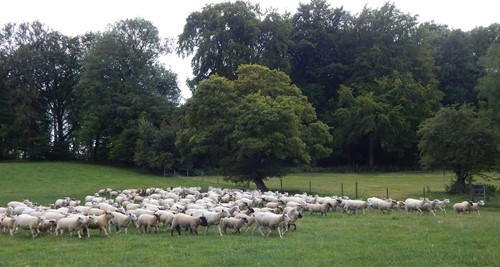Parasite Resistance - FEC
Why Breed for Worm Resistance
 Increasing awareness of the costs associated with worm control and concerns relating to wormer resistance have increased interest in breeding sheep with greater immunity to roundworms.
Increasing awareness of the costs associated with worm control and concerns relating to wormer resistance have increased interest in breeding sheep with greater immunity to roundworms.
The degree to which sheep are affected by the presence of roundworms in their gut is quite variable; with some individuals affected much worse than others.
This variation has a genetic component, which if it can be assessed, can be used to select animals that are genetically more resistant to roundworm infection.
Selecting rams within a closed flock with highly negative FEC EBVs means their progeny have the potential to:
- Perform better e.g. in terms of lamb growth rate require less frequent treatment with anthelmintics
- Lambs shed fewer nematode eggs in their dung, therefore reducing the levels of larval challenge for other sheep (whether these have also been selected for worm resistance or not)
- Ewes sired by more resistant sires shed fewer worm eggs at lambing time, reducing pasture contamination and improving lamb growth rates.
- Reduce the worm burden on heavily stocked pastures over time
Breeding for worm resistance provides both a useful way to improve flock performance and a valuable marketing tool for selling rams. Subsidy is sometimes available from each of the devolved bodies; AHDB, HCC and QMS to support the recording of FEC and enhance its availability to pedigree breeders.
What does it take to breed for worm resistance?
Worm resistance can be assessed by analysing an the Faecal Egg Count (FEC) of lambs at around 21 weeks of age. Breeders send faecal samples to a laboratory, who send FEC scores to Signet for analysis to produce a FEC EBV – indicating resistance to worms.
Remember - before sampling remember: -
- Lambs must be experiencing a worm challenge.
- Test at least 15 lambs to provide a meaningful sample – preferably more
Take a mob sample. Ensure lambs are experiencing a challenge. Only when mob samples are typically over 300-500 eggs per gramme should individual lambs be sampled.
Take meaningful measurements
- The lambs must not have been treated for worms within at least the last 4 weeks.
- Lambs should have graze ‘dirty’ pastures for at least the last 4 weeks.
- Don’t sample lambs given ‘long-acting’ or ‘persistent’ drenches.
- Ensure lambs have been under the same management throughout their life
- Samples should only be sent once lambs are over 18 weeks of age
Samples must be submitted at least 5 days before the BLUP deadline
Numbers to sample
- The most accurate breeding values will be obtained in flocks that sample all their lambs.
- Flocks sampling a subset of their lambs should consider sampling one sex and an absolute minimum of 15 lambs.
- Ideally at least 5 lambs should be sampled by each sire.
- Sample a cross section of the flock, not just the “best” lambs.
Sampling procedure
Information on how to sample lambs will be supplied by your service provider along with the FEC sampling packs